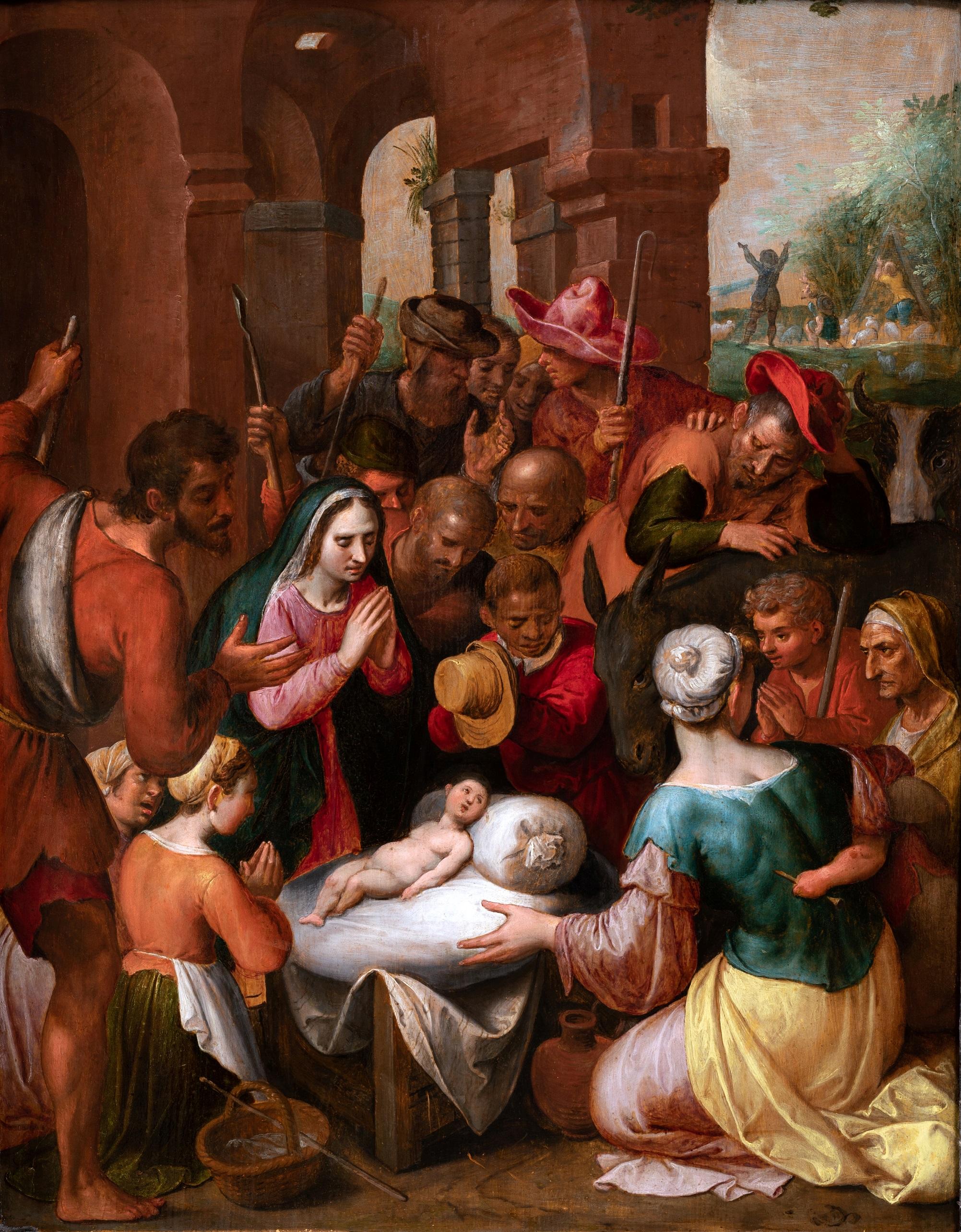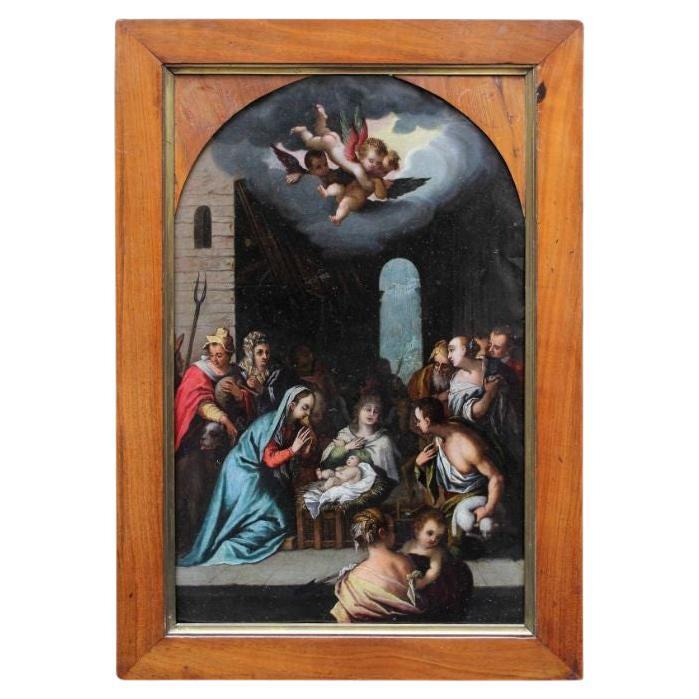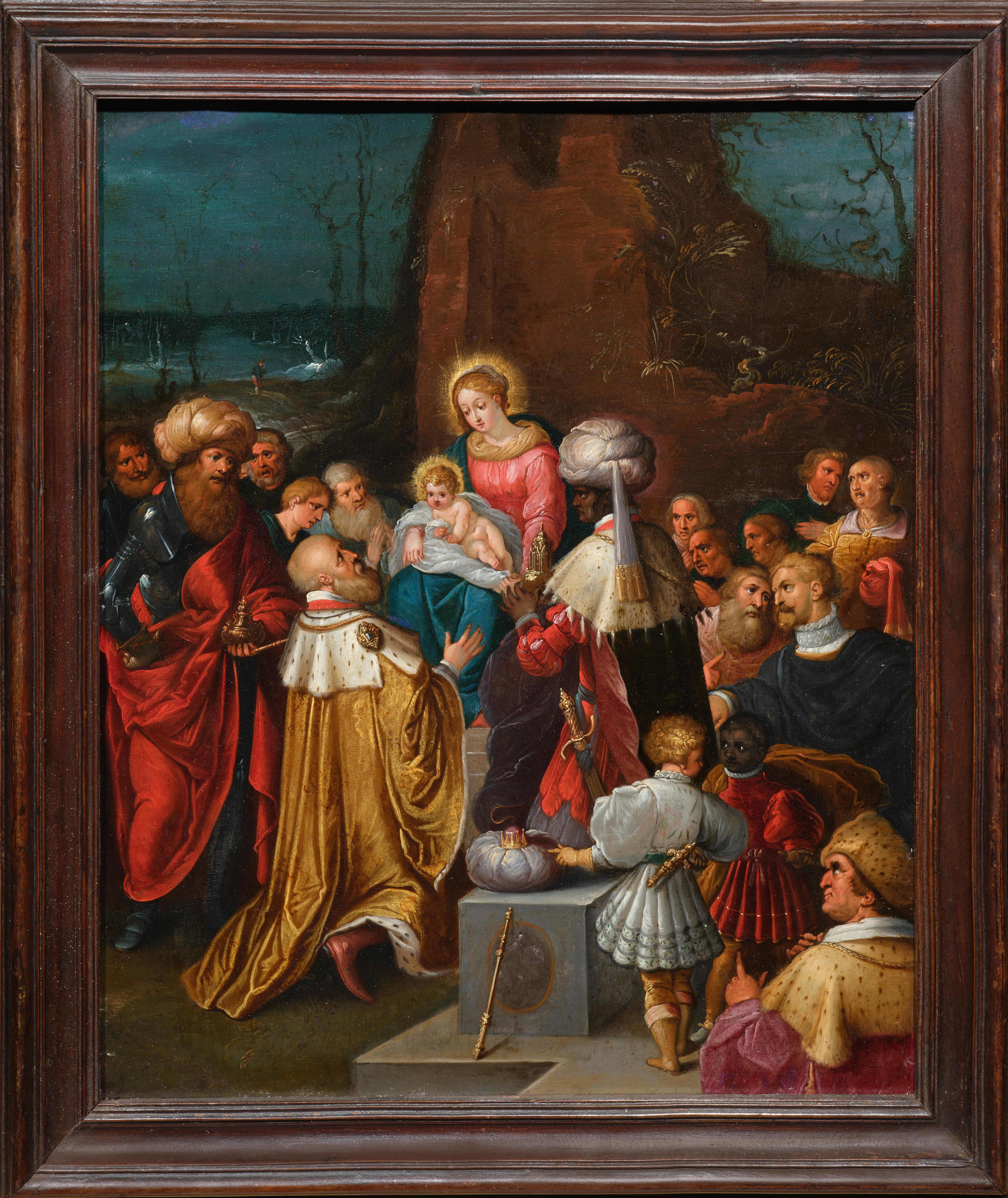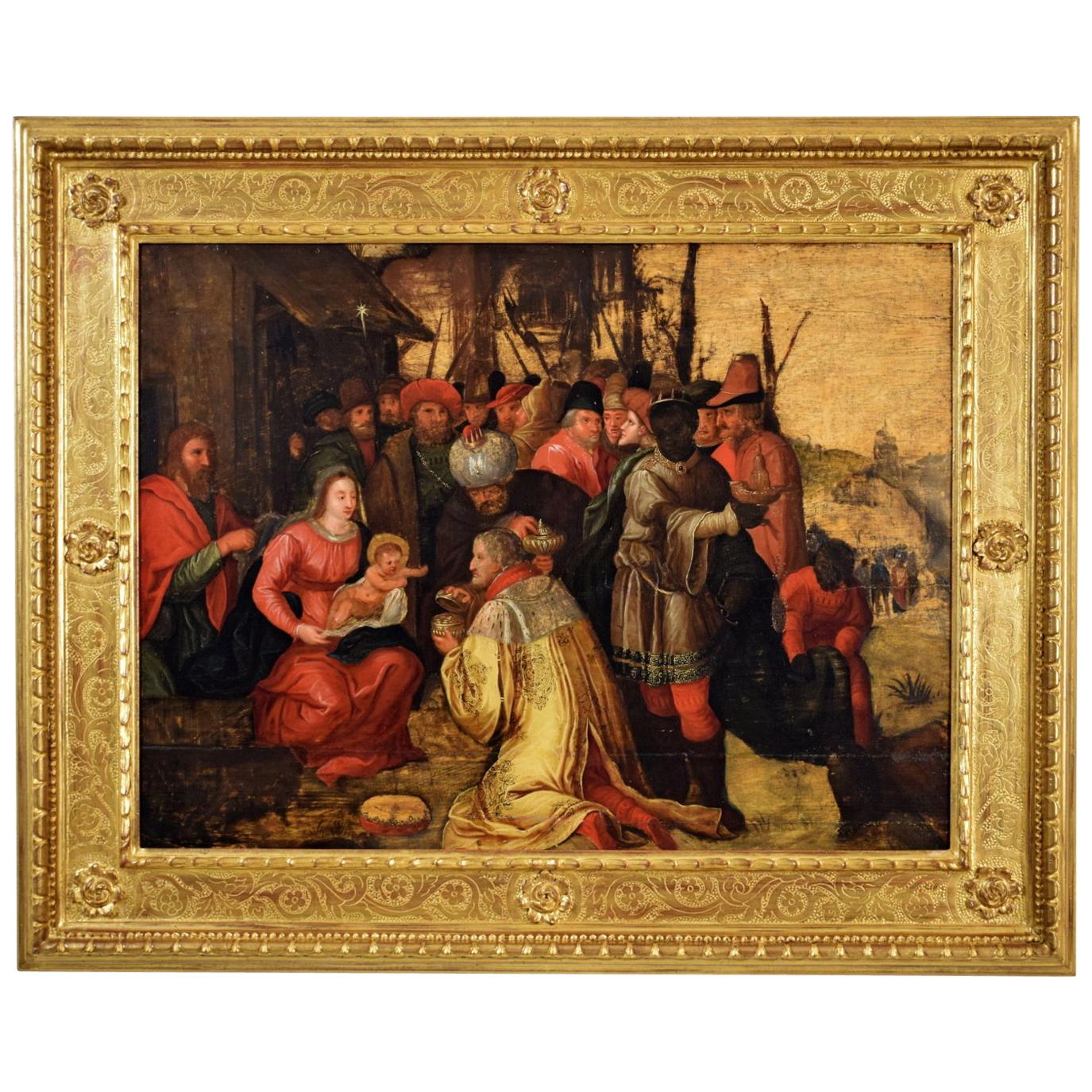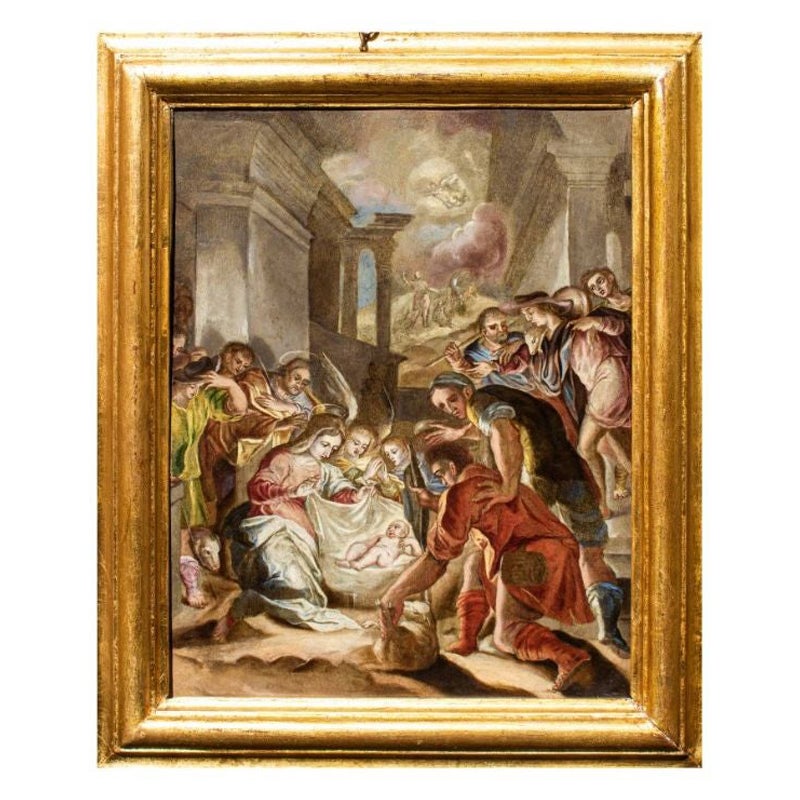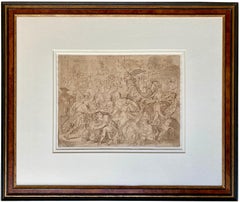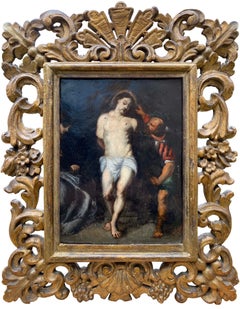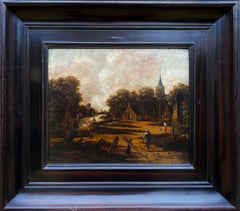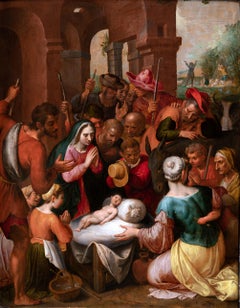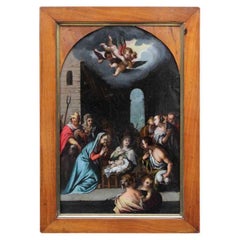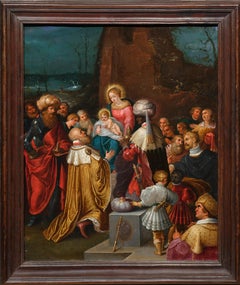Items Similar to Adoration of the Shepherds by Gillis Mostaert (1534 - 1598) Flemish Renaissance
Video Loading
Want more images or videos?
Request additional images or videos from the seller
1 of 21
Gillis MostaertAdoration of the Shepherds by Gillis Mostaert (1534 - 1598) Flemish Renaissance1570s
1570s
$45,993.01
£34,426.92
€39,000
CA$63,299.49
A$70,553.88
CHF 37,017.20
MX$861,577.89
NOK 468,718.24
SEK 443,010.03
DKK 296,895.47
About the Item
Gillis Mostaert
Hulst 1534 – 1598 Antwerp
Flemish Painter
'Adoration of the Shepherds'
Medium: oil on panel
Dimensions: image size 38,5 x 46,5 cm, frame size 54 x 62 cm
Provenance: From a Belgian Private Collection
Notes: Gillis Mostaert was enlisted as a master in the Antwerp Guild of St Luke and was the twin brother of Frans Mostaert (1528 – 1560). Although born in Hulst, in the northern Netherlands, both Gillis and Frans trained in Antwerp - Gillis with Jan Mandijn and Frans with Herri met de Bles. This training explains both Gillis’s attachment to the tradition of Hieronymus Bosch and Frans’s specialization in landscape painting. Gillis Mostaert is a more prolific and versatile artist than has usually been assumed. Apart from landscapes and village scenes, reminiscent of Pieter Bruegel I’s example, he also painted hell and fire scenes, biblical subjects, saints, and mythological themes.
Mostaert was probably the inventor, or at least the only known exponent, of pictures with flat, trompe l’oeil wooden frames on which figures and scenes are depicted surrounding the central theme of the painting. He created such composite paintings from the 1570s onwards, and many are described in 17th-century inventories in Antwerp.
Biography: Gillis Mostaert the Elder (27 or 28 November 1528 – 28 December 1598) was a prominent Flemish Renaissance painter and draughtsman whose artistic versatility and distinctive style left an indelible mark on the art world of Antwerp in the latter half of the 16th century. Celebrated for his winter landscapes, nocturnal scenes, and depictions of fires, Mostaert’s works were among the most coveted pieces of his time. He managed a prolific workshop in Antwerp that catered to prominent patrons and regularly collaborated with leading artists of the period.
Gillis Mostaert was born in Hulst. Karel van Mander, an early biographer of artists, claimed that Gillis was the twin brother of the painter Frans Mostaert and the grandson of Jan Mostaert, a painter. However, modern scholarship questions the accuracy of Jan Mostaert’s relation to Gillis. Gillis’ father, also named Gillis, was a painter himself, which suggests that artistic talent ran in the family.
While Frans apprenticed under the landscape painter Herri met de Bles, Gillis began his studies in landscape painting with Jan Mandijn in 1550, the same year he registered as a pupil with the Antwerp Guild of Saint Luke. Van Mander noted that both brothers joined the Guild in 1555. However, records show that Frans had a pupil by 1553, indicating he may have achieved master status earlier. Gillis likely honed his skills alongside Marten van Cleve and Maerten de Vos in the studio of Frans Floris, the preeminent Antwerp history painter of the era.
In 1563, Gillis married Margareta Baes, with whom he had six children. His standing among fellow painters is reflected in the fact that notable artists Peeter Baltens and Crispin van den Broeck served as godfathers to his children born in 1571 and 1588.
Mostaert’s workshop in Antwerp thrived, producing artworks that commanded high market prices. His pieces were featured in the collections of many important art patrons of the late 16th and early 17th centuries, such as François Perrenot de Granvelle, Archduke Ernest of Austria, and Archduke Leopold Wilhelm of Austria. Filips van Valckenisse, Lord of Hemiksem and one of Antwerp’s greatest art collectors, owned over 50 of Mostaert’s paintings.
Gillis Mostaert’s oeuvre is characterized by a broad range of subjects, including market scenes, village festivals, allegories of the four seasons, winter and snow landscapes, depictions of war and destruction, religious themes, and moral allegories. His adept use of copper as a support for his oil paintings imbued them with a unique luster and glowing appearance.
Mostaert also played a pivotal role in the Mannerist style of the Frans Floris School, characterized by naturalistic depictions of nature, reflective surfaces, and animated compositions populated by numerous figures. He was an imitator of Hieronymus Bosch, drawing inspiration from Bosch’s tapestries created for Cardinal Granvelle. His “Haywain” (Rijksmuseum on loan to the Museum Catharijneconvent) is a satirical allegory criticizing the Catholic Church through the representation of the seven deadly sins.
Mostaert’s “fire paintings,” showcasing his skill in rendering light and fire effects, were highly prized. His masterpiece “Landscape with marauding soldiers” (1569, Louvre) is a nocturnal scene with multiple fires set by soldiers, capturing the chaos and retribution of villagers. He also innovated with composite paintings of biblical scenes framed by smaller grisaille scenes, a style later emulated by artists like Frans Francken the Younger.
Mostaert’s talents were sought after by fellow artists for his skill in adding figures to their works. He collaborated with Cornelis van Dalem, Marten van Cleve, Cornelis Molenaer, Jacob Grimmer, Hendrik van Steenwijck I, and Hans Vredeman de Vries.
Gillis Mostaert died in Antwerp in 1598, leaving behind a significant debt, leading to the dispersal of his workshop’s contents to pay creditors. Despite the challenges of attribution, his innovative contributions to landscape and genre painting, his mastery of light and fire effects, and his capacity to infuse his works with humour and narrative complexity ensure his place as a key figure in Flemish Renaissance art.
- Creator:Gillis Mostaert (1528 - 1598, Flemish)
- Creation Year:1570s
- Dimensions:Height: 21.26 in (54 cm)Width: 24.41 in (62 cm)Depth: 2.37 in (6 cm)
- Medium:
- Movement & Style:
- Period:16th Century
- Condition:The artwork is elegantly presented within a beautiful frame, impeccably preserved in its good condition. This piece is showcased in a state suitable for immediate gallery hanging, having undergone professional review.
- Gallery Location:Knokke, BE
- Reference Number:1stDibs: LU2006214755982
About the Seller
5.0
Vetted Professional Seller
Every seller passes strict standards for authenticity and reliability
Established in 1998
1stDibs seller since 2022
28 sales on 1stDibs
Typical response time: 14 hours
- ShippingRetrieving quote...Shipping from: Knokke, Belgium
- Return Policy
Authenticity Guarantee
In the unlikely event there’s an issue with an item’s authenticity, contact us within 1 year for a full refund. DetailsMoney-Back Guarantee
If your item is not as described, is damaged in transit, or does not arrive, contact us within 7 days for a full refund. Details24-Hour Cancellation
You have a 24-hour grace period in which to reconsider your purchase, with no questions asked.Vetted Professional Sellers
Our world-class sellers must adhere to strict standards for service and quality, maintaining the integrity of our listings.Price-Match Guarantee
If you find that a seller listed the same item for a lower price elsewhere, we’ll match it.Trusted Global Delivery
Our best-in-class carrier network provides specialized shipping options worldwide, including custom delivery.More From This Seller
View All'The Departure of the Israelites from Egypt' by Frans Francken the Younger
Located in Knokke, BE
Frans Francken the Younger
1581 - Antwerp - 1642
Flemish Painter
'The Departure of the Israelites from Egypt – The Exodus', c. 1610 - 1620
Medium: pen in sepia on paper
Dimensions: mage size 26 x 34,5 cm, frame size 55 x 65,5 cm
Biography: Frans Francken the Younger, born in Antwerp in 1581 and passing away on May 6, 1642, also in Antwerp, was a distinguished Flemish painter. He is recognized as the most prominent and productive member of the renowned Francken family of artists. Francken explored a wide range of subjects, creating large altarpieces for churches and producing smaller works depicting historical, mythological, and allegorical scenes. Notably, his depictions of collectors’ cabinets established a popular new genre of art during his era. He was known for collaborating with other artists, enriching their works with his skilled renderings of figures and narrative elements, complementing specialists in landscape, architectural scenes, and floral still-life painting.
Francken was born to Frans Francken the Elder and Elisabeth Mertens. His father was a pupil of Antwerp’s leading history painter, Frans Floris, and a significant creator of altarpieces in Flanders during his time. Francken received his artistic training under the guidance of his father. Additionally, it is possible that Frans and his brother, Hieronymus Francken II, received further instruction in the workshop of their uncle, Hieronymus Francken I, in Paris.
A versatile artist, Francken made significant contributions to various genres within Flemish art, introducing new themes and subjects. Many of his works comprised small-scale historical, allegorical, and biblical cabinet paintings, often emphasizing figures. He is credited with either inventing or popularizing several novel themes that gained popularity in Flemish painting, including genre scenes featuring monkeys (also known as singeries) and Kunstkammer or gallery paintings, presenting a plethora of natural and artistic treasures against a neutral wall. Francken introduced various other unconventional themes that later gained traction, such as the ‘Triumphal Procession of Amphitrite’ and ‘Croesus and Solon.’ He also produced a series of paintings depicting witches and witchcraft, including portrayals of witches’ sabbats.
His remarkable paintings are held in the collections of numerous major museums throughout Europe. Francken specialized in rendering the human figure, as evidenced by etched and engraved portraits of the artist by Anthony van Dyck (after Peter Paul Rubens), identifying him with the Latin inscription: ‘ANTVERIÆ PICTOR HVMANARVM FIGVRARVM’ (Figure painter of Antwerp). He was frequently invited to contribute figures to compositions by other esteemed artists, including landscape artists such as Tobias Verhaecht, Abraham Govaerts, and Joos de Momper...
Category
Early 17th Century Baroque Interior Paintings
Materials
Paper, Pen
The Flagellation of Christ, Old Master, Flemish School, Oil on copper
Located in Knokke, BE
The Flagellation of Christ
Old Master
Flemish School
17th century
Medium: Oil on copper
Dimensions: Image size 22 x 17 cm, frame size 39 x 31 cm
Category
17th Century Baroque Portrait Paintings
Materials
Copper
'Traveller in a Duch Village' by Jan Meerhoud (1633 – 1677) Dutch - Golden Age
Located in Knokke, BE
Jan Meerhoud
Gorinchem 1633 – 1677 Amsterdam
Dutch School
Golden Age
'Traveller in a Dutch Village'
Signature: signed lower left
Medium: oil on panel
Dimensions: image size 21 x 2...
Category
Early 17th Century Dutch School Landscape Paintings
Materials
Oil, Panel
'The Shepherd with his Flock' by Cornelis Van Leemputten ( 1841 – 1902 )
By Cornelis van Leemputten
Located in Knokke, BE
Cornelis Van Leemputten
Werchter 1841 – 1902 Schaerbeek
Belgian Painter
'The Shepherd with his Flock – Le berger et son troupeau'
Signature: signed lower right 'Corn. Van Leemputte...
Category
Late 19th Century Realist Animal Paintings
Materials
Oil, Panel
After the Hunt, Jan Josef Horemans the Younger, Antwerp 1714 – 1790, Flemish
By Jan Josef Horemans the Younger
Located in Knokke, BE
After the Hunt
Jan Josef Horemans the Younger
Antwerp 1714 – 1790
Flemish School
Signature: Attributed to Jan Josef the Younger Horemans
Medium: Oil on canvas
Dimensions: Size incl...
Category
18th Century Flemish School Interior Paintings
Materials
Canvas, Oil
'Landscape with Shepherds and Animals' by Louis - Pierre Verwée ( 1807 – 1877 )
Located in Knokke, BE
Verwée Louis-Pierre
Courtrai 1807 – 1877 Brussels
Belgian Painter
'Landscape with Shepherds and Animals by the Water'
Signature: signed lower right and dated 'L. P. Verwee 1851'
Medium: oil on panel
Dimensions: image size 43 x 52 cm, frame size 58 x 66 cm
Biography: Louis-Pierre Verwee (also spelled Verwée) was born on March 19, 1807, in Kortrijk, Belgium, and died in Brussels in November 1877. He is widely regarded as the leading representative of the Romantic school in Belgian landscape painting, particularly known for his evocative winter scenes and rural landscapes with cattle.
Verwee left school at an early age to pursue his passion for art. He enrolled at the Academy of Fine Arts in Kortrijk, where he studied under Jan Baptiste de Jonghe, a prominent landscape and animal painter. He later continued his artistic training with Eugène Verboeckhoven in Ghent, who would not only become his mentor but also a lifelong friend and collaborator. The two artists often worked side by side, and Verboeckhoven occasionally painted the figures and animals in Verwee’s landscapes, to such a degree that their early works are sometimes difficult to distinguish.
Verwee followed Verboeckhoven to Brussels and established himself as a successful landscape and animal painter. His preferred subjects were winter and summer scenes, typically populated with figures and animals. His style, particularly in his early work, was closely aligned with that of Verboeckhoven. Over time, he became known for landscapes that reflected the romantic tradition, with compositions echoing the work of Andreas Schelfhout, Barend Cornelis Koekkoek, Frans Keelhoff, and Johann Bernard Klombeck. His depictions of forests and rivers often employed a dreamy, atmospheric quality that captured the mood and light of nature.
In his later career, Verwee sought artistic innovation but found himself increasingly focused on variations of winter landscapes after 1837. These scenes, popularized by Koekkoek and Schelfhout, were characterized by low-hanging snow clouds, icy waterways, and a cool palette of light blue and metallic grey, creating a moody and intimate ambiance. Occasionally, other artists such as Florent Willems...
Category
Mid-19th Century Romantic Landscape Paintings
Materials
Oil, Panel
You May Also Like
Cercle of Ambrosius Francken, Adoration of the shepherds, 17th century Antwerp
Located in PARIS, FR
Adoration of the shepherds,
Cercle of Ambrosius Francken,
Early 17th century Antwerp school
Oil on oak panel: h. 55 cm, w. 43 cm (21.65 in x 16.93 in)
17th c. ebonized and moulded f...
Category
Early 17th Century Old Masters Figurative Paintings
Materials
Oil, Wood Panel
16th Century Adoration of the Shepherds Painting Oil on Copper by Carnevale
By Carnevale Studio
Located in Milan, IT
Domenico Carnevale (Sassuolo, 1524 - Modena, 1579) Adoration of the Shepherds
Oil on copper, 42 x 28 cm
Frame 54 x 36 cm
Expert opinion of Prof. Emilio Negro
The painting represents the Adoration of the Shepherds, the Child in the center, next to the Madonna kneeling in prayer and an angel behind her; towards him in the foreground a woman with a child in her arms, a shepherd with a sheep on the right, a bagpiper on the left and various other male and female characters turn to him. The architectures of the background, between which a glimpse of the landscape can be glimpsed, are hidden in the upper part by the clouds, where a "celestial glory" encamps with three flying angels.
The painting shows mannerist characters that can be traced back to the second half of the sixteenth century, and can be traced back to an author from the Modena area, with stylistic references to the Bolognese Samacchini (1532 - 1577) and Passerotti (1529 - 1592). More precisely, it can be attributed to Domenico Carnevale (1524-1579), one of the most important masters of the sixteenth century active in the local area. The Carnival was formed in Emilia, his homeland, where he worked for many years. However, his works also show a clear Roman influence, dictated by a long experience in the city, during which he also dedicated himself to the restoration of the Sistine Chapel. Trained in the late-mannerist environment of Modena, he is also linked to the Parmesan Corrorese and Ferrarese Dossesque tradition; Carnival also always maintains a slight archaic sentiment in his work,
The main stylistic reference must be identified in a work similar in subject and iconographic setting, coming from the church of the Pio Istituto Orfanelle di San Geminiano di Modena, currently part of the Art Collection of the Province, attributed to the same influence as the Carnival. Another interesting comparison should be identified with A Presentation of Jesus in the Temple...
Category
Antique 16th Century Italian Paintings
Materials
Copper
Frans Wouters, Adoration of The Herders, Christmas Scene, Christ, Flemish School
Located in Greven, DE
Frans Wouters was a Flemish Baroque painter who mainly created smaller cabinet pieces.
He was initially apprenticed to Pieter van Avont in Antwerp, but then moved to Rubens‘ worksho...
Category
17th Century Baroque Figurative Paintings
Materials
Oak, Oil
The Adoration of the Magi, an early painting by Frans Francken II (1581 - 1682)
By Frans Francken II
Located in PARIS, FR
We would like to thank Dr. Ursula Härting who, after examining the work, confirmed the autograph nature of this painting by Frans Francken the Younger in a certificate issued on Dece...
Category
1610s Old Masters Figurative Paintings
Materials
Copper
Frans Franken III 16th Century Oil on Wood, Adoration of the Magi, Painting
By Frans Franken the Younger
Located in IT
Frans Franken III and aid, Adoration of the Magi
Good condition
The oil painting on wood, with a gold background, depicts an Adoration of the Magi. The Magi are dressed in sumptuous silk and brocade dresses; they wear precious hats and jewelery. The richness of their garments is in contrast with the humility of the Holy Family and of the other characters who, around curious, observe the scene. The hut is simple, made of wood and straw: above it shines the Comet, symbol of the divine event. In the distance, a group of wayfarers walk along a path that is lost on the horizon, blending into the gold of the bottom.
The representation proposes a traditional iconography, in which the painter inserts some details that he lends himself to symbolic interpretations. Among these is the appearance of the Magi, who from the XIVth century differs iconographically: the wise astronomers represent the homage to Jesus of the then known parts of the world, namely Africa, Asia and Europe. To the right of the Magi, in the foreground, sits a monkey, considered a demonic creature and a symbol of lies and sin. It is depicted on the sidelines, as a defeat, next to a fragment of a classical column: ruin alludes to the end of paganism, of the old world that collapses with the advent of the new one, marked by the birth of Christ and liberation from the Original Sin. On the ruins he climbs the ivy, symbol of the immortality of the soul. The work is attributable to the workshop of the Flemish painter Frans Francken III...
Category
Antique 16th Century Belgian Renaissance Paintings
Materials
Paint
16th Century Adoration of The Shepherds Painting Oil on Copper
Located in Milan, IT
Attr. to Girolamo Siciolante known as da Sermoneta (Sermoneta, 1521 - Rome, 1575)
Adoration of the Shepherds
Oil on copper, 39 x 29.5 cm
Frame 47 x 39 cm
The refined taste, the refined poses, the definition of the anatomies, the vibrant light, allow us to identify for this painting the hand of a Mannerist painter active during the sixteenth century. In particular, the composition and stylistic research allow us to attribute the panel to Girolamo Siciolante, known as da Sermoneta (1521 - 1575). His first training took place under the guidance of Leonardo Grazia known as da Pistoia (1502 - 1548). Later he settled in Rome where he was able to see the painting of Raphael and Michelangelo from life and where he was first a pupil and then a collaborator of Perin del Vaga...
Category
Antique 16th Century Italian Paintings
Materials
Copper
More Ways To Browse
Early Renaissance Art
The Shepherd
Renaissance Panel
Church Interior
Flemish Painters
Antique Flemish Frame
Dior Renaissance
Church Interior Painting
Flemish Panel
Antique Catholic Art
Renaissance Copper
16th Century Renaissance Paintings
Four Seasons Panels
16th Century Painted Panels
Antique Catholic Painting
Adoration Paintings
17th Century Village Paintings
16th Century Religious Painting
